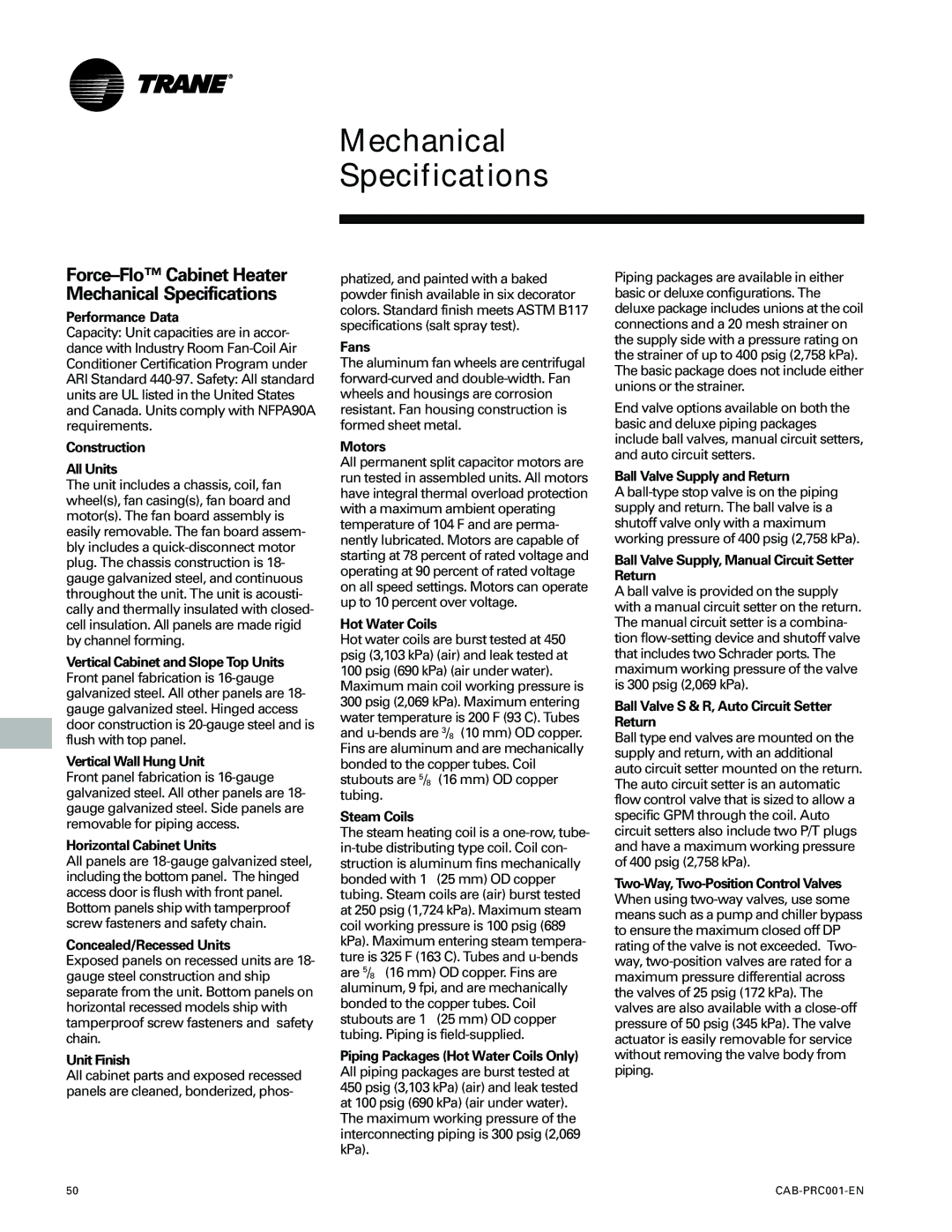Force–Flo™ Cabinet Heater Mechanical Specifications
Performance Data
Capacity: Unit capacities are in accor- dance with Industry Room Fan-Coil Air Conditioner Certification Program under ARI Standard 440-97. Safety: All standard units are UL listed in the United States and Canada. Units comply with NFPA90A requirements.
Construction
All Units
The unit includes a chassis, coil, fan wheel(s), fan casing(s), fan board and motor(s). The fan board assembly is easily removable. The fan board assem- bly includes a quick-disconnect motor plug. The chassis construction is 18- gauge galvanized steel, and continuous throughout the unit. The unit is acousti- cally and thermally insulated with closed- cell insulation. All panels are made rigid by channel forming.
Vertical Cabinet and Slope Top Units Front panel fabrication is 16-gauge galvanized steel. All other panels are 18- gauge galvanized steel. Hinged access door construction is 20-gauge steel and is flush with top panel.
Vertical Wall Hung Unit
Front panel fabrication is 16-gauge galvanized steel. All other panels are 18- gauge galvanized steel. Side panels are removable for piping access.
Horizontal Cabinet Units
All panels are 18-gauge galvanized steel, including the bottom panel. The hinged access door is flush with front panel. Bottom panels ship with tamperproof screw fasteners and safety chain.
Concealed/Recessed Units
Exposed panels on recessed units are 18- gauge steel construction and ship separate from the unit. Bottom panels on horizontal recessed models ship with tamperproof screw fasteners and safety chain.
Unit Finish
All cabinet parts and exposed recessed panels are cleaned, bonderized, phos-
phatized, and painted with a baked powder finish available in six decorator colors. Standard finish meets ASTM B117 specifications (salt spray test).
Fans
The aluminum fan wheels are centrifugal forward-curved and double-width. Fan wheels and housings are corrosion resistant. Fan housing construction is formed sheet metal.
Motors
All permanent split capacitor motors are run tested in assembled units. All motors have integral thermal overload protection with a maximum ambient operating temperature of 104 F and are perma- nently lubricated. Motors are capable of starting at 78 percent of rated voltage and operating at 90 percent of rated voltage on all speed settings. Motors can operate up to 10 percent over voltage.
Hot Water Coils
Hot water coils are burst tested at 450 psig (3,103 kPa) (air) and leak tested at 100 psig (690 kPa) (air under water).
Maximum main coil working pressure is 300 psig (2,069 kPa). Maximum entering water temperature is 200 F (93 C). Tubes and u-bends are 3/8”(10 mm) OD copper. Fins are aluminum and are mechanically bonded to the copper tubes. Coil stubouts are 5/8”(16 mm) OD copper tubing.
Steam Coils
The steam heating coil is a one-row, tube- in-tube distributing type coil. Coil con- struction is aluminum fins mechanically bonded with 1” (25 mm) OD copper tubing. Steam coils are (air) burst tested at 250 psig (1,724 kPa). Maximum steam coil working pressure is 100 psig (689 kPa). Maximum entering steam tempera- ture is 325 F (163 C). Tubes and u-bends are 5/8” (16 mm) OD copper. Fins are aluminum, 9 fpi, and are mechanically bonded to the copper tubes. Coil stubouts are 1” (25 mm) OD copper tubing. Piping is field-supplied.
Piping Packages (Hot Water Coils Only) All piping packages are burst tested at 450 psig (3,103 kPa) (air) and leak tested at 100 psig (690 kPa) (air under water). The maximum working pressure of the interconnecting piping is 300 psig (2,069 kPa).
Piping packages are available in either basic or deluxe configurations. The deluxe package includes unions at the coil connections and a 20 mesh strainer on the supply side with a pressure rating on the strainer of up to 400 psig (2,758 kPa). The basic package does not include either unions or the strainer.
End valve options available on both the basic and deluxe piping packages include ball valves, manual circuit setters, and auto circuit setters.
Ball Valve Supply and Return
A ball-type stop valve is on the piping supply and return. The ball valve is a shutoff valve only with a maximum working pressure of 400 psig (2,758 kPa).
Ball Valve Supply, Manual Circuit Setter Return
A ball valve is provided on the supply with a manual circuit setter on the return. The manual circuit setter is a combina- tion flow-setting device and shutoff valve that includes two Schrader ports. The maximum working pressure of the valve is 300 psig (2,069 kPa).
Ball Valve S & R, Auto Circuit Setter Return
Ball type end valves are mounted on the supply and return, with an additional auto circuit setter mounted on the return. The auto circuit setter is an automatic flow control valve that is sized to allow a specific GPM through the coil. Auto circuit setters also include two P/T plugs and have a maximum working pressure of 400 psig (2,758 kPa).
Two-Way, Two-Position Control Valves When using two-way valves, use some means such as a pump and chiller bypass to ensure the maximum closed off DP rating of the valve is not exceeded. Two- way, two-position valves are rated for a maximum pressure differential across the valves of 25 psig (172 kPa). The valves are also available with a close-off pressure of 50 psig (345 kPa). The valve actuator is easily removable for service without removing the valve body from piping.

